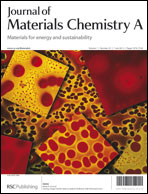A facile fluorine-mediated hydrothermal route to controlled synthesis of rhombus-shaped Co3O4 nanorod arrays and their application in gas sensing†
Abstract
We have successfully synthesized rhombus-shaped Co3O4 nanorod (NR) arrays via a facile fluorine-mediated hydrothermal route involving the formation of Co(OH)F as precursor and then thermal conversion to porous Co3O4. The hydrothermal temperature was critical to the rhombic shape of the nanostructures. At low temperatures, the Co2+ ions interacted with F− anions to form CoF+ complexes and then reacted with OH− to form rhombus-shaped Co(OH)F. Above 100 °C, the disproportionation of formaldehyde from hydrolysis of hexamethylenetetramine (HMT) hindered the formation of Co(OH)F precursor. In this process, CO32− anions direct the dissolution–recrystallization process instead of F− anions due to stronger affinity of CO32− to Co2+. During the transformation from the precursor to the oxide, various annealing temperatures affect the gas sensing performance. The synthesized rhombus-shaped Co3O4 NR arrays gas sensor annealed at 450 °C showed the highest sensitivity to ethanol because of good contact, porous structure, good crystallinity, high surface-to-volume ratio and open space.


 Please wait while we load your content...
Please wait while we load your content...